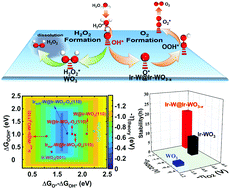Regulating the adsorption behavior of intermediates on Ir–W@Ir–WO3−x boosts acidic water oxidation electrocatalysis†
Abstract
Tungsten oxide with strong acid resistance and weak O-binding ability could potentially achieve a tradeoff on the O-binding properties by constructing W and Ir dual sites for acidic oxygen evolution reaction (OER) catalysis. However, the peroxide intermediate formed during the OER process could react with tungsten oxide to produce soluble species, thereby severely limiting its application. Herein, we construct Ir–W@Ir–WO3−x core–shell nanoparticles with an Ir–W metallic core and an Ir-doped WO3−x (Ir–WO3−x) shell, which can deliver an impressive overpotential of 261 mV at 10 mA cm−2 for acidic OER catalysis and extraordinary catalytic stability. Spectroscopic analysis manifests that Ir–W@Ir–WO3−x could substantially suppress peroxide species formation and effectively avoid peroxide-induced corrosion during the OER process. Theoretical studies reveal that the moderate O-binding capability on Ir–W@Ir–WO3−x not only accelerates catalytic kinetics, but also restrains hydroperoxide formation. This work sheds light on the rational design of OER catalysts by modulating the adsorption behavior of oxygen-containing intermediates.

- This article is part of the themed collection: 2021 Materials Chemistry Frontiers HOT articles


 Please wait while we load your content...
Please wait while we load your content...